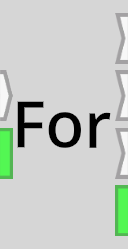For (LogiX node)
Revision as of 01:31, 7 November 2022 by ProbablePrime (talk | contribs)
| For | ||
|---|---|---|
 | ||
| Inputs | ||
| Impulse | Run | |
| Int | Count | |
| Bool | Reverse | |
| Outputs | ||
| Impulse | LoopStart | |
| Impulse | LoopIteration | |
| Impulse | LoopEnd | |
| Int | Iteration | |
The For node is used to fire impulses from the LoopIteration output a specific number of times when an impulse is received at Run.
Usage
- The
Countinput determines how many times impulses will be fired from theLoopIterationoutput. The default is 0. This count, is evaluated immediately after theLoopStartimpulse chain has completed, just before any impulses are fired fromLoopIteration.
- The
Reverseinput controls if theIterationoutput value is incremented or decremented eachLoopIteration. The default is False, meaningIterationis incremented each iteration.
- The
LoopStartoutput fires an impulse once after an impulse is received atRun. This impulse chain will complete before any impulses are fired fromLoopIteration.
- The
LoopIterationoutput fires impulses sequentially until the total number which have been fired is equal to theCountinput. Each impulse chain started fromLoopIterationcompletes before the following one is fired. Nodes which split the chain will cause the For node to continue with subsequent iterations without waiting for the split chain's completion.
- The
LoopEndoutput fires an impulse once the final impulse chain started fromLoopIterationhas ended.
- The
Iterationoutput value is either incremented or decremented each time a new impulse is fired fromLoopIteration, depending on the value ofReverse. IfReverseis False,Iterationis incremented each time an impulse is fired fromLoopIterationstarting with the value 0, during the first iteration, and ending withCount- 1 on the final iteration. IfReverseis True, theIterationvalue isCount- 1 on the first iteration and decremented each time down to 0 on the final iteration.
Impulse chains started from this node effectively continue the one which arrived at Run, meaning that any temporary values from previous nodes are still available. All iterations from LoopIteration complete within a single frame update and therefore this can produce framerate hitches if an excessively demanding computation is performed. There is a failsafe which will put this node into an error state (node visual turns red) if a frame is delayed excessively - this helps prevent complete freezes.